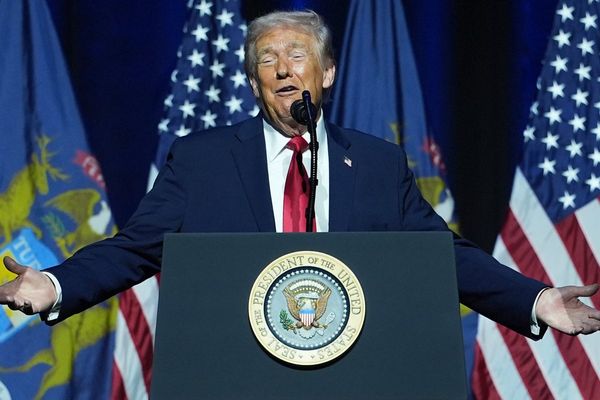Struggle is not new to Shajahanpur, a district in the Terai region of Uttar Pradesh that has produced young martyrs — Ram Prasad Bismil, Ashfaqulla Khan, and Thakur Roshan Singh — in India’s freedom movement. It is also known for the hardships of its farmers and the vast tracts of arable land that play an important role in feeding the country and its most populous State. Today, U.P. produces a little less than 30% of India’s wheat, more than any other State, as per government data.
Powayan Taluk, less than 30 kilometres away from Shajahanpur, is known as Mini Punjab, as most farmers here are descendants of those who came from the land of the five rivers in the late 1960s and early 1970s, in search of cultivable land.
Avtar Singh, in his 70s, was one of them. Now bed-ridden, he arrived in 1972 from Gurudaspur with his family. Balwinder Singh, 38, his 6-foot tall, well-built son, remembers the difficult times his family had when crops such as wheat and paddy were new to the region.
Avtar was one among about 37,000 Sikhs (as per the 2011 Census) who brought modern ways of farming wheat and paddy from Punjab to Powayan. Balwinder, proud of the family’s achievement, cultivates wheat on more than 100 acres of land, most of it leased from his neighbours. There’s a brand-new high-power Sonalika tractor in front of the house. As he surveys the land under cultivation, he says, “Ours is one of the first families in this area to purchase this huge vehicle. We also have a harvesting machine that can easily be fitted to the tractor.”
All nine members in Balwinder’s family work the fields. “From the beginning we, as children, helped our father. There was a jungle here. With his hard work, he made this land fertile,” he says, silencing his German Shepherd with just a whistle.
Costs and prices
In 1972, there were no markets in Powayan, and no good fertilisers, seeds, or machinery available close by. Farmers like Avtar went to Shajahanpur to sell their produce. Now, they have one and the district has about four food grain markets. Mechanisation has become the norm. The problem that persists is the prices for the produce.
From the 100 acres, the Singhs get about 1,300 quintals of wheat in one crop in a year. “We got ₹50-60 a quintal in 1972, when we started. Now, it’s ₹2,275 per quintal. This price doesn’t match our production cost,” says Balwinder, wishing that the minimum support price (MSP) on wheat was increased. “Seed sellers offer us ₹2,450 per quintal; multinational companies offer ₹2,500. Farmers naturally try to get better money to realise their input costs and hard work.” He is wary of the big players though: “They may reduce prices, so it is for the government to ensure that food grains are procured at a remunerative price,” Balwinder says, suggesting that a model similar to Haryana and Punjab be employed in Uttar Pradesh.
There, Agriculture Produce Marketing Committees (APMCs) control the procurement for the government. APMCs have commission agents who broker between the government or traders and the farmers. Known as arhatiyas, they take a commission of 2.5% and their business is one of the oldest systems in Indian agriculture. In Uttar Pradesh, while APMCs exist, the government prefers to procure directly from farmers at MSP.
Over the past three years, farmers in Shajahanpur and similar markets for wheat in Uttar Pradesh are holding their harvest. They are waiting for big corporations to enter the market with a price higher than the MSP. This year they hope that a bonus will be announced after the elections. The Shajahanpur market, one of the largest food grain markets in Uttar Pradesh, wears a deserted look even as the wheat harvest is over.
Farmers’ leaders, traders, and commission agents see this delay in sales as a strategy by big corporations. They believe that farmers will initially get a higher amount than the MSP, but once the monsoon sets in and small farmers face a storage problem, the corporations will lower the prices.
“Had the MSP been remunerative and had the procurement been robust, no farmer would have kept their wheat,” says D.P. Singh, a leader of Samyukt Kisan Morcha, the umbrella body for about 500 farmers’ organisations that led the anti-farm laws struggle along Delhi’s borders.
Simarjeet Singh, in his 40s, a relative of the Singhs, says his input costs have doubled in the last decade but the MSP hasn’t correspondingly increased. “I cultivate wheat in about 60 acres. The government gives us a subsidy on power for eight hours only. The government can take money from us, but we need power for at least 16 hours. Running tube-well pumps on diesel is not viable,” he says.
Procurement problems
To attract farmers to markets, APMCs have started lucky-draws. In 2023, the APMC in Powayan gave out three tractors worth ₹6 lakh each, along with other farm machinery. This hasn’t helped the markets.
Singh cites the decreasing procurement from Uttar Pradesh.: “Uttar Pradesh produced about 340 lakh metric tonnes (LMT) of wheat in the last rabi (winter) crop season of 2022-23. In the last 10 years, we see that on average, 30 LMT of wheat has gone to the Food Corporation of India (FCI) from Uttar Pradesh. But the agency [that ensures food security by procuring, storing, and distributing food grain] procured just 3.3 LMT in the last season. Where has the wheat gone? It all went to the big players who can hoard it for long,” Singh says.
He adds that corporations are making the best of the global situation, including the war in Ukraine that began in February 2022. Ukraine (then the world’s fifth largest exporter of wheat), suffered, pushing international prices up. Russia was the top exporter. The Union Government banned wheat exports in May 2022, to control rising prices in domestic markets. India, whose wheat exports had touched $243 million in 2020 before the ban, was then the 10th largest wheat exporter in the world, as per data from the United States Department of Agriculture.
Jitender Singh Hudda, another farmers’ leader in western Uttar Pradesh, believes that the Centre’s decision to ban export of wheat was to help the big players hoard the grain. “Had there been exports, demand would have increased, and it would have helped farmers. The way out is to allow export through government agencies, such as the State Trading Corporation or cooperatives such as Nafed,” he says.
The production of wheat this year is estimated by farmers and traders to have increased at least 6% in U.P. Millers and traders are feeling the pinch as they have no system to take on organised players in processing foodgrains. They too believe the government is helping big players to gain control over the food supply chain in the area, disrupting age-old practices involving commission agents, traders, and small and medium enterprises.
Covert market control
Uma Shankar Gupta is the president of Arti Vyapar Mandal, the association of commission agents in the Shajahanpur market. In his small office within the market, he pulls copies of written complaints to the government, from a bunch of papers. He has been asking, on behalf of his colleagues, for a system where commission agents can procure food grains from farmers for the Food Corporation of India. So far, he says the government has ignored their pleas.
“During harvest season, we used to get more than 50,000 quintals per day in this market. Now, it is as low as 1,000 quintals, as farmers are holding their grain. They are expecting better prices,” he says, adding that big business that entered the market about five years ago, directly purchase from the farmers. “Now the government has opened 24 centres in this market. More than 1 lakh quintals have been procured by the government from this market since the harvest started in the first week of April, but it’s too little. It will go up if the government allows commission agents to work,” he says. “The government is putting pressure on the APMC to delay the purchasing,” he alleges.
Gupta, a Bharatiya Janata Party (BJP) supporter, says since the BJP government has come to power, his income has come down to half. “But we will vote for the BJP. It’s for Hindutva. We, the praja, will do what our raja wants,” he says.
Ritesh, another commission agent, says the Shajahanpur APMC market buys food grains from five districts. “We have the maximum arrival of wheat and paddy in Uttar Pradesh as we have more purchasers,” he says, adding that the Ukraine crisis should have given Indian farmers and traders new markets if export of wheat hadn’t been banned. He is upset that “the government is trying to portray us as instigators for the farmers’ protests”. He says, “big companies have a large working capital, storage, and purchasing power, and government policies are in their favour.” He adds that farmers in Uttar Pradesh are not united like those of Punjab and Haryana.
Ram Chandra Singhal, former president of the Flour Millers Association in U.P. and a member of the Rashtriya Swayamsevak Sangh-sponsored Laghu Udyog Bharati, an organisation of micro, small, and medium enterprises, started as a commission agent in Shajahanpur in 1968. His flour mill, situated on the outskirts of Shajahanpur, provides jobs for about 200 people. Walking around his factory, he remembers the struggles he and his family have gone through.
He remembers that people in the area used to cultivate cotton, corn, groundnut, mustard, and sesame, until the Punjab farmers began cultivating sugarcane, wheat, and paddy. “They came to Powayan first. Some of them went to Lakhimpur Kher, some went to Pilibhit, and land prices increased. Naturally, sugar mills, rice and flour mills started functioning in this area,” Singhal says.
Singhal would purchase wheat from farmers for the FCI and the State government. In 1971 he started a rice mill and in 1990, a flour mill. “I cannot compete with big companies like ITC, Reliance, and Adani. Many small mills have closed since their entry. We have been asking the government to ensure a level playing field. We had sugarcane crushers, and mills for pulses and edible oils. Most are shut now,” he says, hoping the new government (at the Centre) does not provide more advantages to big players. “The new government should protect MSMEs which have the capability of solving the problem of unemployment,” he adds.
Sonu Khandelwal, a trader and a keen market-watcher based in Bareilly, says there’s a trend to note here. Khandelwal’s trading agency, Jagdish International, buys food grains and lentils from almost all markets across seven States in north India. His office on Kali Bari Marg in Bareilly is modern, unusual for traders’ offices in the region. Khandelwal also thinks more shrewdly: “If 10 farmers in one village hold their wheat and gain good prices, the next year the number will increase. Some farmers are holding thousands of quintals of wheat expecting better prices,” he says, adding that FCI’s buffer stock is decreasing.
“There’s a perception that all middlemen are bad. No, this is also a trade, a business, a work involving lakhs of people and their families. Most traders are farmers too.” He is more hopeful than most: “It will take several years for MNCs to end the present system,” he says, also indicating that the struggles of farmers and traders against the big players will continue.







